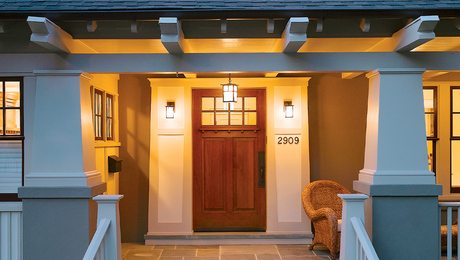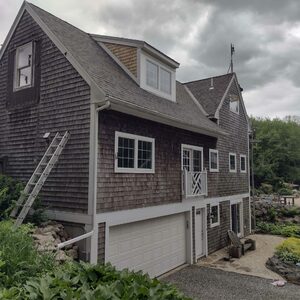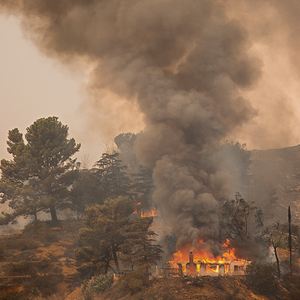Electric Service Upgrade Revisited
Armed with the knowledge of our previous discussions, I revisited my electric service upgrade.
Advice sometimes conflicts. How many amps should I allow for welding? My welder is going to cost less than $500 and 1K at the very most. Should it exceed these cost estimates, reworking the service should not be a big issue.
There’s a box above my fuse panel. It’s got a 100 Amp breaker in it and a lever on the side that shuts off the power. What do people call this thing? Is it usually on the outside of the building so the fire department can cut the power?
Since I have this switch/breaker all I really need to upgrade my 4 circuit box is what they call a main lugs load center, true?
One of my knowledgeable sources claims that breakers could be interchangable by brand if I install the right panel. He thinks GE offers great flexibility. True?



















Replies
Welders can be all over the place. I have seen reports for some that need 80 amps.
But at that price range I suspect that it will be much less, maybe 30 amps, but you should check the specs on some sample units first.
"There's a box above my fuse panel. It's got a 100 Amp breaker in it and a lever on the side that shuts off the power. What do people call this thing? Is it usually on the outside of the building so the fire department can cut the powe"
That would be the main disconnect. But I am not familar with one that has both a switch and breaker, unless the level is just an arm to trip the breaker. Typically the breaker is used also used as the switch.
Code does require that the main disconnect be on the outside of the building, but some local codes do. Use utilities might require. But code allows it to be on the inside and as near as practical where the power comes inside.
Now for this to be a proper main disconnect the neutral and the wire from the ground electrodes have to come together at one point and be bonded to the case. From that point a separate ground and neutral wires would be run to the sub-panels.
"One of my knowledgeable sources claims that breakers could be interchangable by brand if I install the right panel."
Yes, No, Maybe.
There are a number of brands that are of a "universal" size, but there is no 3rd party spec that has standardized the desgin. So some brands will interchange with some other brands (some one way). But in general they are only approved with for use in the same panel.
I will leave it to one of the electricans that has more experience to suggest what might be the most universal brand.
> unless the level is just an arm to trip the breaker.
That's the way this one works. It is old. My locality does not have an electrical code or a building inspector. The coop has some guidelines. But they don't care about customer equipment. It will be closer to NEC compliance when I get done than it is now.
Another issue is the ground rod. I am going to run 0 up the mast. I believe the service drop is #2 triplex.I plan to join these two with this square deal that has some set screws. They call it something like a gurney. These wires are AL.
The coop wants a #6 copper run to a ground rod. Does it run down the mast and you drill a hole in the LB for it to go to the ground rod? Does it go with the one aught in the gurney under the set screw.
Based an Hartman's post, it's terminated in the main disconnect. Electrically it's all one node. When lightning strikes it's all gonna get real hot. But if it goes up there with the one aught then there's cu and al together. That's not good.
Have used many a welder and an ironworker in my garage. Never tripped a breaker. As long as the breaker isn't fused (bonded) together I guess that is good. My current welder, a Miller MIG, lists 208/230/460. For those voltages the amps listed respectively: 42/38/19. It was 3 phase when I bought it used and I had the local welding supply swap the 3 phase power supply for a single phase. (Power company got all excited or concerned when I ask for a 3 phase drop in a residential neighborhood)
The load center I have was made by Murray and the house built in 1968. It only has a 125 amp capacity. I plumbed a gas line to the utility room so I could use a gas dryer. Used the former dryer circuit/s (two breakers clipped together) to run a line to a wall mounted receptacle (I still call it 220v) plugged in the 3 blade welder plug and have been welding ever since.
I don't have any main disconnect on the Murray, either as a breaker or a lever (codes change). I built on over and above the original house (I'll finish that someday) so had a new, larger load center installed (200 amp without checking).
I ran some large conduit (2" at least) from the new center to the old so it became a branch. Other circuits from the new center went to the addition. The new load center has a main disconnect. The local power guys came over, cut the original feed, hand carried it (this is coming right from the pole!) to the new load center mast, crimped it with a special tool, ran some tape around it, and presto I had 200 amps! Huh? They explained the feed (AL) was air cooled, could handle the load and my stuff in the conduit (big around as your little finger) had to be bigger because it was enclosed (more heat).
The breakers feeding my welder are each labled 50 amps. I don't think that means a total of 100 amps but is how the legs for 220v vs 110v get tied together. I'm not an electrician.
Curious about that ground you mentioned. Mine comes right out of the meter box and ties to a ground rod. I think it ties to a cold water pipe too. (copper pipe). I was trying to help a friend work the paperwork through the city for a permit (he wanted to build a metal building for a Class A motorhome) and the city guy said that when the footings were formed up and ready for inspection, we could also have a grounding system in or around the concrete checked off to eliminate the rod. Seems the drying out of the climate in Colorado cut down on moisture making a rod less and less effective.
Remember something an electrician I hired told me. A one man shop uses one power tool at a time. 50 amps for tool #1, then off, 50 amps for tool #2, then off. Conversely a multiperson shop might be using 100 amps at one time. Even though lights don't draw that much current, I ran them on a dedicated circuit so if I ever did pop a breaker at least I could see where to go to snap it back on.
If you are possibly dropping a grand on a welder then other things will come. (Call my wife!). Hire an electrican for an hour to inspect your system and tell him what you want to do. It will pay off in many ways. Tyr
PS Oxy/Acet Welding eliminates all of this.
I could not find Murray breakers but took an old one to a supply house and a Square D fit fine. Also found that breakers were available configured so that where formerly one 15amp breaker fit (one circuit) two seperate 15amp circuits could be used (two circuits). Sounds like you have few circuits. A new box has to be filled with new breakers (more bucks). Is it really a fuse panel (time travelers hop on) controlled by a breaker? Where are you?
I'm down in the MO-Ozarks, miles from civilizatiion.
My meter and old disconnect are on the pole across the 80' of driveway. Next years budget calls for new meter base and 200 A breaker over there. Coop says they will upgrade wire from xformr too, #4 AL triplex. Maybe when the fridge comes on the lights won't dim.
IIRC I saw Murray boxes and breakers at the farm store day before yesterday. I would not be supprised if this electric service does not date to the fifties. Then again it could have been built with a bunch of salvaged parts.
A farmer does not get to say - I remodel your kitchen ma'am it'll be $12K knowing he'll make a 10% profit. A farmer works to produce as cheap as he can. The farmer shoots himself in the foot too often because the cheapest, usually isn't.
My Welding for Dummies book says I should start with gas. I doubt I'll ever buy a big welder. Too many of the local boys have them and maybe even know what they are doing. Like buying a 1 ton dually, it's just gonna be cheaper to hire it done.
I know the boys before me left some clear code violations and safety hazards. Mine will be better.
Your cu. ground wire does not go up the mast. It goes through the meter base to the driven ground unbroken by any splices or joints.
If the main disconnect is a subpanel disconnect the ground from your new subpanel should go directly from the panel to the ground rod w/o going through the main dissconnect.
Dave